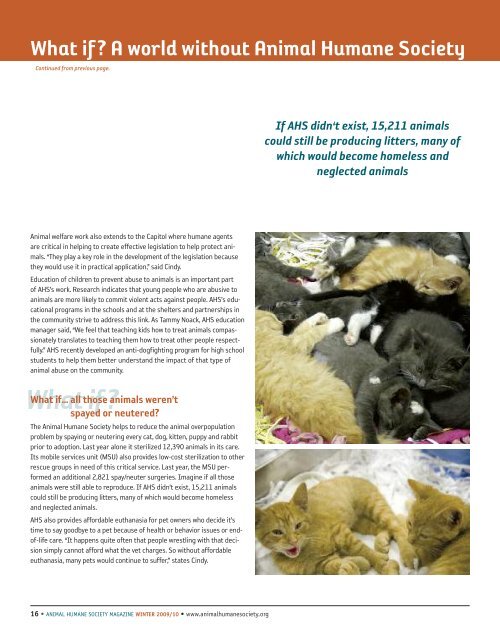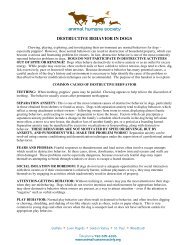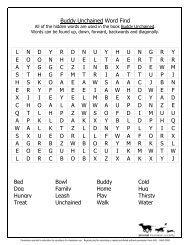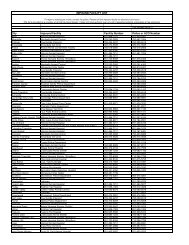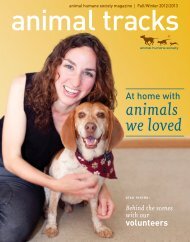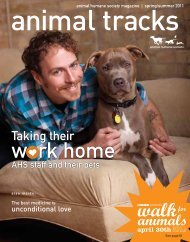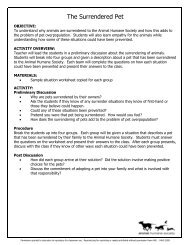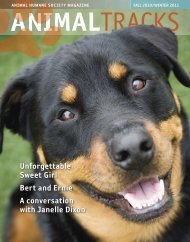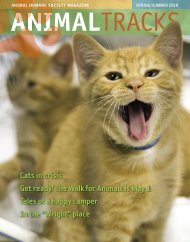No place to go Bringing the story home - Animal Humane Society
No place to go Bringing the story home - Animal Humane Society
No place to go Bringing the story home - Animal Humane Society
Create successful ePaper yourself
Turn your PDF publications into a flip-book with our unique Google optimized e-Paper software.
What if? A world without <strong>Animal</strong> <strong>Humane</strong> <strong>Society</strong><br />
Continued from previous page.<br />
<strong>Animal</strong> welfare work also extends <strong>to</strong> <strong>the</strong> Capi<strong>to</strong>l where humane agents<br />
are critical in helping <strong>to</strong> create effective legislation <strong>to</strong> help protect animals.<br />
“They play a key role in <strong>the</strong> development of <strong>the</strong> legislation because<br />
<strong>the</strong>y would use it in practical application,” said Cindy.<br />
Education of children <strong>to</strong> prevent abuse <strong>to</strong> animals is an important part<br />
of AHS’s work. Research indicates that young people who are abusive <strong>to</strong><br />
animals are more likely <strong>to</strong> commit violent acts against people. AHS’s educational<br />
programs in <strong>the</strong> schools and at <strong>the</strong> shelters and partnerships in<br />
<strong>the</strong> community strive <strong>to</strong> address this link. As Tammy <strong>No</strong>ack, AHS education<br />
manager said, “We feel that teaching kids how <strong>to</strong> treat animals compassionately<br />
translates <strong>to</strong> teaching <strong>the</strong>m how <strong>to</strong> treat o<strong>the</strong>r people respectfully.”<br />
AHS recently developed an anti-dogfighting program for high school<br />
students <strong>to</strong> help <strong>the</strong>m better understand <strong>the</strong> impact of that type of<br />
animal abuse on <strong>the</strong> community.<br />
What if… all those animals weren’t<br />
spayed or neutered?<br />
The <strong>Animal</strong> <strong>Humane</strong> <strong>Society</strong> helps <strong>to</strong> reduce <strong>the</strong> animal overpopulation<br />
problem by spaying or neutering every cat, dog, kitten, puppy and rabbit<br />
prior <strong>to</strong> adoption. Last year alone it sterilized 12,390 animals in its care.<br />
Its mobile services unit (MSU) also provides low-cost sterilization <strong>to</strong> o<strong>the</strong>r<br />
rescue groups in need of this critical service. Last year, <strong>the</strong> MSU performed<br />
an additional 2,821 spay/neuter surgeries. Imagine if all those<br />
animals were still able <strong>to</strong> reproduce. If AHS didn’t exist, 15,211 animals<br />
could still be producing litters, many of which would become <strong>home</strong>less<br />
and neglected animals.<br />
AHS also provides affordable euthanasia for pet owners who decide it’s<br />
time <strong>to</strong> say <strong>go</strong>odbye <strong>to</strong> a pet because of health or behavior issues or endof-life<br />
care. “It happens quite often that people wrestling with that decision<br />
simply cannot afford what <strong>the</strong> vet charges. So without affordable<br />
euthanasia, many pets would continue <strong>to</strong> suffer,” states Cindy.<br />
16 • ANIMAL HUMANE SOCIETY MAGAZINE WINTER 2009/10 • www.animalhumanesociety.org<br />
If AHS didn‘t exist, 15,211 animals<br />
could still be producing litters, many of<br />
which would become <strong>home</strong>less and<br />
neglected animals


